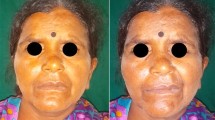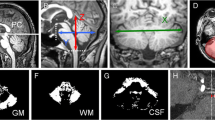Abstract
The role of hypertension in the late onset of hemifacial spasm (HFS) is evaluated in a family, spanning four generations. Magnetic resonance imaging (MRI) and magnetic resonance angiography (MRA) revealed a variable anatomical relationship between nervous and vascular structures in the symptomatic cerebello-pontine angle. In one case, showing neurovascular conflict (NVC), microvascular surgical decompression was followed by clinical resolution of HFS. Neuroimaging suggesting NVC was found in all symptomatic patients of the last two generations and in three younger subjects not affected by HFS. As a determinant for the late development of clinical expression is reviewed the role of arterial hypertension, detected few years before HFS appearing in all symptomatic subjects. The distribution of NVC in several members of the same family suggests a genetic susceptibility towards vascular anomaly.



Similar content being viewed by others
References
Wang A, Jankovic J (1998) Hemifacial spasm: clinical findings and treatment. Muscle Nerve 21:1740–1747
Nielsen VK (1984) Pathophysiology of hemifacial spasm, I: ephaptic transmission and ectopic excitation. Neurology 34:418–426
Sanders DB (1989) Ephaptic transmission in hemifacial spasm: a single-fiber EMG study. Muscle Nerve 12:690–694
Digre K, Corbett JJ (1988) Hemifacial spasm: differential diagnosis, mechanism and treatment. In: Jankovic J, Tolosa E (eds) Advances in neurology: facial dyskinesias. Raven Press, New York, NY, 49:467–472
Barker FG II, Jannetta PJ, Bissonette DJ, Shields PT, Larkins MV, Jho HD (1995) Microvascular decompression for hemifacial spasm. J Neurosurg 82:201–210
Rakover Y, Dharan M, Rosen G (1996) Hemifacial spasm associated with external carotid artery compression of the facial nerve. J Laryngol Otol 110:1081–1083
Ryu H, Yamamoto S, Sugiyama K, Uemura K, Miyamoto T (1998) Hemifacial spasm caused by vascular compression of the distal portion of the facial nerve. Report of seven cases. J Neurosurg 88:605–609
Platania N, Nicoletti GF, Barbagallo G, Albanese V (1997) Concurrent trigeminal and glossopharyngeal neuralgia, hemifacial spasm and hypertension by neurovascular compression. Case report. J Neurosurg Sci 41:303–307
Kobata H, Kondo A, Iwasaki K, Nishioka T (1998) Combined hyperactive dysfunction syndrome of the cranial nerves: trigeminal neuralgia, hemifacial spasm, and glossopharyngeal neuralgia: 11-year experience and review. Neurosurgery 43:1351–1361
Ho SL, Cheng PW, Wong WC (2000) A case-controlled MRI/MRA study of neurovascular contact in hemifacial spasm (Correspondence). Neurology 55:155–156
Friedman A, Jamrozik Z, Bojakowski J (1989) Familial hemifacial spasm. Mov Disord 4:213–218
Carter JB, Patrinely JR, Jankovic J, McCrary J, Boniuk M (1990) Familial hemifacial spasm. Arch Ophtalmol 108:249–250
Coad JE, Wirtschafter JD, Haines SJ, Heros RC, Perrone T (1991) Familial hemifacial spasm associated with arterial compression of the facial nerve. J Neurosurg 74:290–296
Micheli F, Scorticati MC, Gatto E, Cerosimo G, Adi H (1994) Familial hemifacial spasm. Mov Disord 9:330–332
Barbosa ER, da Costa Mdo D, Staut CC, Bacheschi LA, Bittar MS (1998) Familial hemifacial spasm: report of 2 cases. Arq Neuropsiquiatr 56:111–115
Miwa H, Mizuno Y, Kondo T (2002) Familial hemifacial spasm: report of cases and review of literature. J Neurol Sci 193:97–102
Duff JM, Spinner RJ, Lindor NM, Dodick DW, Atkinson JLD (1999) Familial trigeminal neuralgia and contralateral hemifacial spasm. Neurology 53:216–218
Van HT, Deguine O, Esteve-Fraysse MJ, Bonafe A, Fraysse B (1999) Relationship between cochleovestibular disorders in hemifacial spasm and neurovascular compression. Laryngoscope 109:741–747
Bernardi B, Zimmermann RA, Savino PJ, Adler C (1993) Magnetic resonance tomographic angiography in the investigation of hemifacial spasm. Neuroradiology 35:606–611
Jespersen JH, Dupont E, Gelineck J, Lundorf E (1996) Hemifacial spasm: magnetic resonance angiography. Acta Neurol Scand 93:35–38
Fukuda H, Ishikawa M, Okumura R (2003) Demonstration of neurovascular compression in trigeminal neuralgia and hemifacial spasm with magnetic resonance imaging: comparison with surgical findings in 60 consecutive cases. Surg Neurol 59(2):93–100
Janetta PJ (1980) Neurovascular compression in cranial nerve and systemic disease. Ann Surg 192:518–525
Adams CBT (1989) Microvascular compression: an alternative view and hypothesis. J Neurosurg 70:1–12
Janetta PJ (1990) Cranial rhizopathies. In: Youmans JR (ed) Neurological surgery, vol 6, 3rd edn. WB Saunders, Philadelphia, pp 4169–4182
Tan EK, Chan LL, Jankovic J, Ho SL, Cheng PW, Wong WC (2000) A case-controlled MRI/MRA study of neurovascular contact in hemifacial spasm. Neurology 55:155–156
Hardy DG, Rhoton AL Jr (1978) Microsurgical relationships of the superior cerebellar artery and the trigeminal nerve. J Neurosurg 49:669–678
Lang J (1983) Clinical anatomy of the head. Springer, Berlin, p 360
Jannetta PJ (1977) Observations in the etiology of trigeminal neuralgia, hemifacial spasm, acoustic nerve dysfunction and glossopharingeal neuralgia. Definitive microsurgical treatment and results in 117 patients. Neurochirurgica 20:145–154
Sunderland S (1948) Neurovascular relations and anomalies at the base of the brain. J Neurol Neurosurg Psychiatry 11:243–257
Sendeski M, Aguiar PH, Zanetti MV, Teixeira MJ, Cescato VA (2002) Neurovascular compression associated with trigeminal neuralgia and systemic arterial hypertension:surgical treatment. Stereotact Funct Neurosurg 79:284–290
Author information
Authors and Affiliations
Corresponding author
Rights and permissions
About this article
Cite this article
Lagalla, G., Logullo, F., Di Bella, P. et al. Familial hemifacial spasm and determinants of late onset. Neurol Sci 31, 17–22 (2010). https://doi.org/10.1007/s10072-009-0153-4
Received:
Accepted:
Published:
Issue Date:
DOI: https://doi.org/10.1007/s10072-009-0153-4




